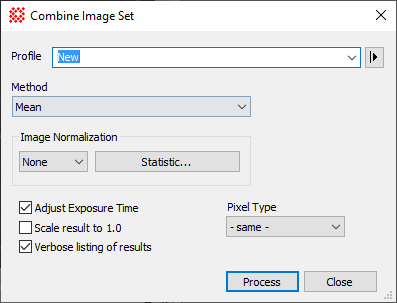The Combine Image Set command opens from
the Image Window > Process >
Calibration menu when an Image Set is displayed in the top-most window. It is
also opens using the ![]() button on the
Animation Bar.
button on the
Animation Bar.
Combine Image Set
The Combine Image Set command combines the members of a displayed Image Set into a single new image. Several statistical methods are available for combining the images and for adjusting ("normalizing") them to a common reference value (see Statistical Estimators for Image Combining).Normalization is used to adjust the images to a common statistical value when using any combining method that rejects bad data such as the mean, rank, and alpha methods. Statistical methods for computing the normalization values are discussed in Region Statistics Estimators. This command is often used following image registration. The related Combine Files command works with images in files, rather than displayed in memory.
The Combine Image Set command opens from
the Image Window > Process >
Calibration menu when an Image Set is displayed in the top-most window. It is
also opens using the ![]() button on the
Animation Bar.
button on the
Animation Bar.

|
Combine Image Set Properties |
|
|
Profile [|>] |
Selects the parameter profile for this command and allows you to save or work with existing presets. |
|
Method |
This list box selects the type of processing used to combine the image values. These are described in Statistical Estimators for Image Combining. If the combining method has parameters, such as high and low sign clipping limits, they are shown in fields to the right of the Method selection. |
|
Image Normalization |
This control group specifies whether the images are adjusted (normalized) to a common statistical value before being combined. If normalization is not set to "none", then the[Normalization Statistic] button opens the Region Statistics dialog. In this dialog you specify how the normalization is to be computed, including the target statistic and the region over which it is calculated. See the discussion below. |
|
[Normalization Statistic] |
Click this button to open the Region Statistics dialog for selecting normalization properties. |
|
Pixel Type |
Select a Pixel Type for the output image that can accommodate the increased signal and dynamic range of the combined images. For example, if combining a large number of 16-bit integer type images it is usually prudent to set the Pixel Type of the output image to 32-bit real. |
|
|
Check this box to update the exposure time in the output image so that it is characteristic of the exposure time of an equivalent single image. This can be used to maintain the image flux, or the value of signal per unit time. This option also updates the mid-time of the exposure based on the weighted combination of the mid-times of all the combined images. The mid-time is saved in the keywords DATE-MID and TIME-MID, which can be used by the photometry tools. |
|
|
Check this box to normalize the combined image to a reference statistical value of 1.0. The Normalization settings are used to compute and apply the scaling. Use this setting, for example, when creating a flat field correction frame manually, rather than by using the Create Master Flat command. |
|
|
Check this box to list detailed messages about the combining process. |
Normalization is used to adjust the images to a common statistical value when using any combining method that rejects bad data. This is essential when using a combining method that performs rejection of bad data, such as the Sigma Clipping, Min/Max or Median methods.
Choose the normalization operation, Scale, Offset, or None, according to the nature of the difference between the images being combined.
If the pixel values differ because of an additive offset, like variations in the CCD bias offset, select Offset.
If the images differ because of a scale factor, as caused by differences in illumination or exposure time, select Scale.
The None setting disables normalization.
This part of the combining procedure works like to the Normalize Image command.
Statistical Estimators for Image Combining
Mira Pro x64 8.72 User's Guide, Copyright Ⓒ 2024 Mirametrics, Inc.
All Rights Reserved.